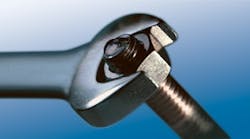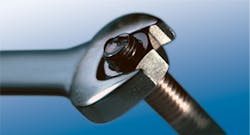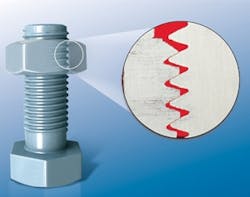Maintenance engineers want to maximize the reliability, function, and efficiency of plant equipment and processes while increasing quality and productivity. Equipment failure is an unwelcome but unavoidable reality that negatively affects a facility’s production time, order fulfillment capability and workplace safety.
By looking at data on where equipment failures have historically occurred in hundreds of plants over a number of years, engineers can identify specific areas where failure is most likely to happen and schedule maintenance activities based on these predictions. Through the planned and selective application of sealants, coatings, and adhesives, manufacturers can protect equipment and facilities from wear, damage and corrosion, extending service life, reducing incidents of catastrophic failure and saving millions of dollars in unscheduled downtime costs each year.
This article lists five of the most common equipment and facility failures, and explains what can be done through preventive maintenance to anticipate their occurrence or limit their severity.
1. Vibrational loosening
Vibration, torque, shock, fatigue failure, thermal expansion and contraction – all of these outside forces can cause threaded fasteners like screws and bolts to loosen over time. The result of such failures can range from minor annoyances such as equipment noise to catastrophic failures. For example, on the EQ-4B Global Hawk, one of the U.S. military’s most advanced and expensive drones, screws holding a critical part that controlled movement of the wings weren’t tight enough and shook loose during a mission over Afghanistan. Within 3 minutes of the fasteners’ loosening, the $72.8 million drone crashed into the remote desert, unrecoverable.
While typical fastener failures do not result in such dramatic and devastating loss, the problem can be permanently and inexpensively fixed. Two very different strategies can counteract fastener loosening – mechanical locking methods and chemical threadlocking systems, also called machinery adhesives. But one method is much less costly and more reliable than the other.
While mechanical locking devices can help resist loosening, they cannot reliably prevent loosening caused by side sliding motion. These devices must be sized appropriately for each specific fastener, resulting in large and costly parts inventories. No locking device seals threads, which leaves assemblies vulnerable to rust and corrosion.
Threadlocking or machinery adhesives are a reliable and inexpensive way to ensure that a threaded assembly will remain locked and leak proof for its entire service life. These single-component anaerobic adhesives are applied to the threads of a bolt as a liquid, stick or tape. The adhesive fills the grooves of the threads and cures to a hard thermoset plastic when exposed to active metal ions in the absence of air. Machinery adhesives lock threaded parts together, ensuring that mating parts will ultimately act as one conjoined unit that resists failure and delivers the greatest possible reliability.
Threadlockers fill voids 100 percent to lock the threads and maintain consistent clamp load over time. Prior to cure, these adhesives lubricate the assembly to reduce friction and torque load during fastener tightening (Figure 1). Post-cure, threadlockers seal the assembly to prevent corrosion and seizure, and ensure that disassembly is consistent and predictable.
2. Air and hydraulic leaks from threaded fittings
Air and fluid leaks in threaded pipe systems are often caused by vibration or constant pressure changes. These leaks are costly and can result in a multitude of maintenance issues including equipment downtime, safety hazards, time required for cleanup of large spills, and waste disposal costs.
To give an idea of the cost of fluid leaks, one drop of hydraulic fluid dripping out of a system every 10 seconds equates to the loss of 40 gallons of fluid per year at a cost of approximately $200 per year. A single air leak through a 1/16-inch opening results in more than 278,000 cubic feet of air lost per month or 3.3 million cubic feet per year at a cost of just shy of $1000 per year.
Depending on the type of equipment, leaks can occur from more than one place – drain plugs, oiler nipples, fittings – wherever there is air space between threads (Figure 2). Leaks occur due to a number of factors. For example: the approximate metal-to-metal contact of pipe threads is just 15 percent, which allows air and fluid to pass through open spaces; threads can be damaged by wear or improper assembly; temperature changes lead to thermal expansion and contraction that results in spaces between components.
Thread sealants can reduce or eliminate leaks by forming a protective barrier that moisture, air, gas and oil cannot penetrate. These sealants create an instant seal and will not evaporate or dry up. Like threadlockers, these anaerobic adhesives cure in the absence of air when exposed to metal ions. The sealant will never evaporate or dry up, facilitates assembly by lubricating the threads, and delivers an instant, universal seal on all types of fittings.
3. Spun bearings and keyway wallow
Many maintenance professionals still rely only on extremely high friction to lock fitted parts together. Tightening tolerances is a very expensive operation, as is creating a finer finish. Even when appropriate allowances and finishes are painstakingly calculated and created to achieve maximum friction, fitted part failure can occur. Bearings are prone to spinning either on their shafts or within their housings, resulting in damage regardless of whether they have been pressed, shrink or slip fitted in place. Bearing replacement can range from less than $100 to $20,000 depending on the equipment and the application.
If a key stock is not secured in place, the fit between the key stock and keyway can loosen and the keyway can wear out. Keyway wallow is a common failure for couplings, sprockets and sheaves and can result in failures such as sheared key stocks or damage to the coupling.
Retaining compounds, specifically formulated to join cylindrical, unthreaded metal parts, can solve the problems of spun bearings and keyway wallow. Designed to provide strength and reliability, these adhesives enable maintenance professionals to establish joints with a robust fit and to seal parts to prevent corrosion.
Traditional interference fits generate strength solely from the metal-to-metal contact of surface peaks, an area that represents only 20% to 40% of the joint surface area. The cured retaining adhesive fills the inner space between components and provides a physical and chemical barrier that eliminates fretting, oxidation and galvanic corrosion. The adhesive also seals the joint against leakage.
4. Gasket failure
Mechanical seals that fill the irregular spaces between mating surfaces to prevent fluid or gas leakage when the surfaces are subject to compression, gaskets can take two forms -- pre-cut shaped solid materials called compression gaskets, and formed in place chemical gasketing materials called flange sealants.
Failure and leakage of compression gaskets have four primary causes.
- Compression gaskets provide less than 100% surface contact between the gasket and the mating substrates, so minor leakages almost always occur even with new gaskets.
- Gasket materials relax under dynamic loads and decrease in thickness. The subsequent loss of bolt tension or compression set results in leakage.
- Gaskets can be squeezed out or displaced from their correct seat between flanges. Bolts can be tightened unevenly creating more stress in certain areas and introducing leak paths.
- The highest stresses on the gasket material occur under the bolt head, where gaskets tend to crack, tear, rupture or extrude, a situation known as bolt hole distortion.
Formed-in-place gasket sealants prevent failure by acting as both a gasket sealant and a gasket adhesive between the two mating flanges. These liquid sealants do not rely on compression to form a seal. They completely fill the space between the flange surfaces, preventing the escape of gases and fluids in machine parts or pipe connections, while adhering strongly to the flange surfaces to enhance the strength of the assembly. Gasket sealants eliminate corrosion and provide an instant, low-pressure seal on an assembly. Once cured, these adhesives resist displacement better than conventional gaskets and will not shrink, crack or relax.
By using formed-in-place liquid sealants instead of conventional pre-cut compression gaskets, no proactive maintenance is required once the flanges are mated. Maintenance professionals can reduce costly gasket inventories, eliminate gasket failure and the resulting time and cost, eradicate gasket-related leakage and provide an instant seal that resists chemicals and fluids.
5. Equipment wear
Physical damage to equipment can be caused by mechanical attack, chemical attack, and corrosion. Examples of wear are easy to find in any industrial facility. Pump casings and impellers wear as a result of abrasive slurries and solids, cavitation and chemical attack that wear down internal sections of the equipment. In the case of pipes and ducts, most wear occurs at elbow bends where fluid flow changes direction. Some plants are forced to repair or replace duct elbows every three months, adding significantly to labor and material costs.
Many facilities only conduct maintenance on large equipment once damage becomes extremely apparent or a catastrophic failure occurs such as a hole in a sidewall or a part dropping off. When critical failure occurs, equipment must be shut down for an unscheduled, costly, and time consuming repair.
Reactive maintenance procedures force the plant to make quick fixes where parts are reinforced, patched, rebuilt or completely replaced to get back up and running as soon as possible. If repaired or replaced parts are put back into service without protecting the parts against recurrent damage, the service life of that equipment will be less predictable and the chances of another unscheduled critical failure increase.
To deliver long-term protection from wear, abrasion, chemical attack and corrosion, epoxy-based wear resistant coatings containing ceramic fillers can be applied to vulnerable metal surfaces to protect them and minimize planned and unplanned downtime (Figure 3). These coatings are two-part epoxy systems containing ceramic beads or ceramic powder, and silicon carbide. The epoxy-base polymer that adheres the ceramic material to the substrate is formulated to be extremely robust, offering excellent performance under high compression and high impact loads.
Wear resistant coatings act as a sacrificial and renewable working surface, preserving the structural integrity of the base substrate and preventing wear caused by abrasive particles, slurries and chemical exposure. These engineered coatings can be applied to worn equipment for restoration or to new equipment before it is placed into service.




